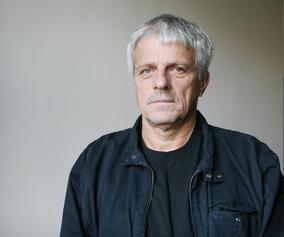Josef Žáček
Born 26 Mai 1951 in Prague. During the period 1977–1983 studied painting at the Academy of Fine Arts in Prague under professor Oldřich Oplt. In 1993 he received a scholarship and participated in the Project ARTEST, Sant Abbondio – Ticino. His works are in collections worldwide. Revolver Revue Prize Laureate in the 2014.
Žáček’s Stubborn Uncertainty
What pictures of evangelists, dogs and lemmings have in common with portraits of those who are called terrorists might be expressed with the word uncertainty. This term, however, loses its negativity once we realise that everything to which we ascribe the character of certainty is such thanks to the firm coherence of human cognitive constructs. Their certainty is proved by the fact that the construction fits together and works. What kind of proof is that, however? The symbolic value of the sign of the cross unlocks the door to the secret of human co-existence, but also serves as a neutral sign, which can be used for the benefit of this or that arbitrariness. How can a cross be painted so that it is a key to the secret of the human world and not just a tool for someone’s power? The court sentenced the R.A.F. members as terrorists on the basis of certain legal constructions. Doubts about these constructions are raised by the circumstances of arrest, imprisonment and the very process itself, as well as by the causes of the whole “terrorist” activity, which lie in the opaque reality of institutionalized violence. A “higher” justice that would draw aside the veil of human constructs is not available to man. What we are left with is an uncertainty justifying deep tolerance and the desire for truth. It is this uncertainty that Josef Žáček paints. […]
Žáček’s artistic stance is that of a resolute but rather complex relation towards the current artistic world. In fact he does not differ much from contemporary painters on the world stage. Rather the contrary: his radicalness is nothing else than the basic tendency of the development of art in the last two centuries, to provide an alternative to thinking, whose main, if not only, goal is to control reality so that it serves our needs and set goals, which immediately raises the question who is included under “our”. The radicalness of Žáček’s painting is not reflected in the way of painting as it is in its total lack of care about what institutions should do about his works. Žáček not only does not care about current trends, as Jirous pointed out, he does not care where his paintings end up. The distribution of Žáček’s work will no doubt meet serious problems due to scale, numerous cycles and even socially controversial issues (Who will put upon their walls a picture of R.A.F. members, of Seaside partisans). “The paintings of Josef Žáček are not of this world” (M. I. Jirous) and there is no place ready for them in this world.
This fact, however, is significant for the character of Žáček’s work: its social and political contexts, paradoxically, leads to the fact that these works are not acceptable by social institutions. The content of the concept of art goes far beyond the “world of art”, as it was understood by Arthur Danto1. If we call it the “art industry” today, then Žáček’s work does not belong into this context, not just because of the above mentioned “problems” (scale and topics), but in principle. Art as industry is, in a way, a justifiable unity of individual and institutional activities, while Žáček’s work focuses on problematizing the institution as such. Not that institutions are his enemies. He just sees too clearly that any institution created by man approaches the sensitive events of human cohabitation inadequately and abstracts them into a form required by the technical means of communication. If institutions are characterised by being controlled by generally set rules, then even the language is an institution. Even the language, if it is to be communicated, must have its rules, albeit these rules will always be in opposition to the uniqueness of the artist’s intention and invention.
Žáček’s painting language is a pronounced expression of this tension that casts doubt on any formation, any effort to incarnate the signified into a generally acceptable form of the signifier, to transform a live idea into a sign bound with the content. It is the vibrating adventure in the background of his paintings that by repeated washing of the traces of the brush and new drawing interventions creates a field of signs that are not yet born – the painter uses the word “foetus”. Similarly, the figures of his paintings that refer to cultural contexts and, at the same time, undermine their institutionalized form or draw attention to social events, by implicitly demonstrating the tragic lack of maturity in people who appear in them on both sides.
Ludvík Hlaváček
In: Anticorps, GHMP, Colloredo-Mansfeld palace, Prague 2017; extract from the text Žáček’s Stubborn Uncertainty.
1Arthur Danto, Artworld. Journal of Philosophy 1964, no. 61, p. 541, Czech transl. Aluze 2009, no. 1




